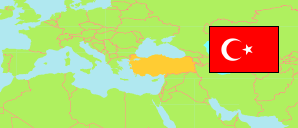
Turkey: Ardahan
Districts
The population of the districts in the Province of Ardahan.
| Name | Status | Population Estimate 2009-12-31 | Population Estimate 2013-12-31 | Population Estimate 2017-12-31 | Population Estimate 2022-12-31 | |
|---|---|---|---|---|---|---|
| Çıldır | District | 10,833 | 10,476 | 9,361 | 8,693 | → |
| Damal | District | 6,977 | 5,897 | 5,345 | 4,866 | → |
| Göle | District | 30,912 | 28,032 | 25,178 | 22,900 | → |
| Hanak | District | 10,346 | 9,804 | 8,887 | 8,054 | → |
| Merkez | District | 40,455 | 40,874 | 41,758 | 41,672 | → |
| Posof | District | 8,646 | 7,699 | 6,567 | 6,296 | → |
| Ardahan | Province | 108,169 | 102,782 | 97,096 | 92,481 |
Contents: Cities, Towns and Villages
All cities, towns and villages in the Province of Ardahan with 750 inhabitants or more.
| Name | Status | District | Population Estimate 2009-12-31 | Population Estimate 2013-12-31 | Population Estimate 2017-12-31 | Population Estimate 2022-12-31 | |
|---|---|---|---|---|---|---|---|
| Ardahan | City | Merkez | 17,171 | 18,857 | 21,696 | 23,295 | → |
| Aşıkşenlik | City | Çıldır | 963 | 957 | 792 | 802 | → |
| Bağdaşen | Village | Merkez | 1,067 | 1,025 | 992 | 882 | → |
| Çamlıçatak | Village | Merkez | 774 | 786 | 893 | 939 | → |
| Çıldır | City | Çıldır | 1,502 | 1,913 | 1,781 | 1,719 | → |
| Damal | City | Damal | 3,804 | 3,210 | 2,983 | 2,772 | → |
| Göle | City | Göle | 6,231 | 6,094 | 6,091 | 5,653 | → |
| Hanak | City | Hanak | 4,030 | 3,221 | 2,860 | 2,819 | → |
| Köprülü | City | Göle | 2,126 | 2,193 | 2,069 | 1,997 | → |
| Koyunpınarı | Village | Hanak | 1,066 | 945 | 888 | 779 | → |
| Posof | City | Posof | 1,810 | 1,962 | 1,959 | 2,063 | → |
| Samandöken | Village | Göle | 993 | 933 | 829 | 789 | → |
| Senemoğlu | Village | Göle | 1,149 | 1,126 | 1,051 | 986 | → |
| Sulakyurt | Village | Merkez | 1,005 | 988 | 939 | 912 | → |
| Tunçoluk | Village | Merkez | 1,366 | 1,170 | 1,047 | 807 | → |
Source: State Institute of Statistics, Republic of Türkiye.
Explanation: Since 2013, the population figures of cities in metropolitan provinces are calculated by using the population of selected neighborhoods.